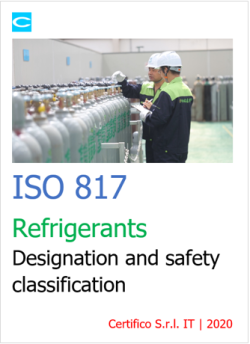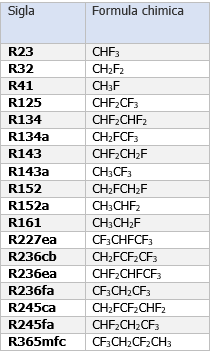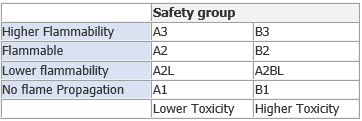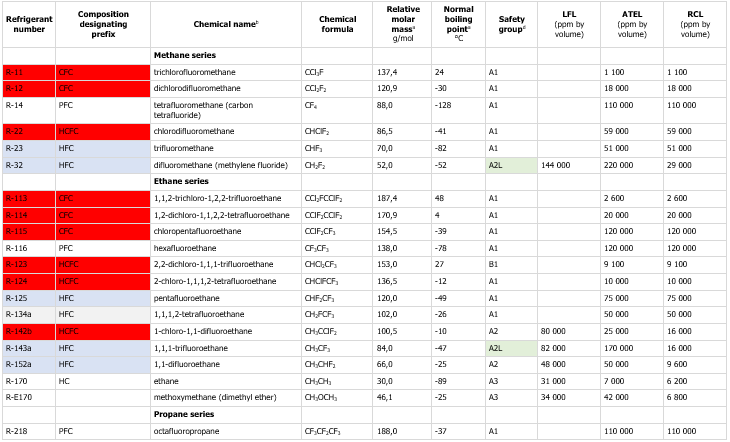ISO 817 Refrigerants - Designation and safety classification
| Appunti Chemicals | ||
| 15 Maggio 2025 | ||
| Salve Visitatore | ||
|
ISO 817:2014 Refrigerants - Designation and safety classification ID 10484 | 31.03.2020 Documento di approfondimento sulla norma ISO 817:2014. La norma fornisce un sistema inequivocabile per la designazione dei refrigeranti. Stabilisce inoltre un sistema per assegnare una classificazione di sicurezza ai refrigeranti in base alla tossicità e ai dati di infiammabilità e fornisce un sistema per determinare il limite di concentrazione del refrigerante. Le tabelle della norma elencano le designazioni del refrigerante, le classificazioni di sicurezza e i limiti di concentrazione del refrigerante in base ai dati resi disponibili. Con il Decreto 10 marzo 2020 è consentito l'impiego di fluidi classificati A1 o A2L (non infiammabili o a bassa infiammabilità) secondo la norma ISO 817 « Refrigerants - designations and safety classification » o norma equivalente, negli impianti di climatizzazione e condizionamento inseriti nelle attività soggette ai controlli di prevenzione incendi. In particolare, l'uso di un gas a bassa infiammabilità, come quelli classificati A2L, è consentito in accordo all'art. 2, comma 1, del Decreto 10 marzo 2020 in vigore dal 18.06.2020. (GU n. 73 del 20-3-2020)[/box-info] I refrigeranti utilizzabili sono stabiliti in accordo al Regolamento (CE) 1005/09 (Ozone-Depleting Substances -ODS) e al Regolamento (UE) 517/2014: CFC - Proibiti dal 31 dicembre 2000. HCFC - Proibiti dal 1 gennaio 2015 (Fino al 31 dicembre 2019, come previsto dal Regolamento (CE) 1005/09 in deroga al divieto, gli idroclorofluorocarburi (HCFC) potranno essere immessi sul mercato per essere riconfezionati e successivamente esportati. Dopo questa data la loro produzione cesserà completamente). HCF - Riduzione dei consumi entro il 2030. L’eliminazione completa del cloro dalla composizione dei refrigeranti ha portato alla nascita degli idrofluorocarburi (HFC), refrigeranti che hanno effetto nullo per quanto riguarda il buco dell'ozono. Tuttavia anche tali fluidi non sono perfettamente eco-compatibili, in quanto la loro liberazione in atmosfera contribuisce ad aumentare l’effetto di surriscaldamento della Terra (effetto serra). Per tale ragione già si prospetta una graduale loro eliminazione, soprattutto in quegli impianti dove possono essere sostituiti da altre tipologie di refrigeranti meno inquinanti (ossia che presentano un valore del GWP molto più basso). Per l'installazione, la manutenzione e l'assistenza agli impianti caricati con HFC il tecnico frigorista deve essere in possesso della necessaria certificazione (patentino). Il successo di questo tipo di refrigeranti non è stato finora esaltante, soprattutto per quanto riguarda l’utilizzo come fluidi puri. Questo è dovuto soprattutto al fatto che i fluidi HFC non offrono nella maggior parte dei casi prestazioni comparabili con i refrigeranti CFC e HCFC, per cui l'operazione di retrofit dei vecchi impianti non risulta sempre di semplice e possibile effettuazione. La tabella a lato riporta alcuni refrigeranti HFC. Uno dei pochi HFC che si è imposto sul mercato e che viene utilizzato allo stato puro è l’R134a, utilizzato con successo nella sostituzione dell’R12 alle medie ed alte temperature, nella refrigerazione domestica ed in alcune applicazioni di nicchia. Il suo utilizzo avveniva anche negli impianti di climatizzazione dei veicoli dopo il divieto d’uso negli stessi dell’R22, ma la Direttiva Europea 2006/40/CE ne ha in seguito proibito l'uso nei veicoli omologati dopo il 1°gennaio 2011. Comunque nella riconversione di impianti da R12 a R134a, a parità di potenza del compressore, l’R134a fornisce una resa frigorifera leggermente inferiore dell’R12, soprattutto per le temperature di evaporazione più basse. Per alcuni refrigeranti HFC (ad esempio l’R32, l’R143a, l’R152a) esiste il problema della loro leggera infiammabilità e, per l'R32 delle alte pressioni di lavoro. Proprio all'R32 si sta guardando come possibile sostituto dell'R410A negli impianti di condizionamento in quanto è un refrigerante con GWP molto più basso dell'R410A. Comunque gli HFC non sono gas tossici. Oggigiorno gli HFC trovano maggior impiego come componenti di miscele. L’opportuno dosaggio di più fluidi HFC (ed eventualmente anche insieme agli idrocarburi) permette di ottenere determinati composti che posseggono le caratteristiche termodinamiche necessarie a sostituire i refrigeranti CFC ed HCFC negli impianti esistenti. L’utilizzo di tali miscele pone però, talvolta, alcune problematiche nuove nel processo di retrofit (in taluni casi è necessario sostituire l'olio del compressore, cambiare il dispositivo di espansione, modificare le regolazioni o sostituire gli elementi di tenuta) e nell'operazione di carica (carica liquida). Nella refrigerazione commerciale a bassa temperatura trovano impiego due miscele, l'R404A e l'R507A, entrambe con un GWP molto elevato e quindi già destinate entro pochi anni ad essere proibite dal nuovo Regolamento Europeo 517/2014. Tabella 1 – HFC Di seguito alcune delle disposizioni introdotte dal Regolamento (UE) 517/2014: - in caso di perdite accertate dal circuito frigorifero l'operatore ha il dovere di farla riparare senza ingiustificato ritardo. Inoltre, durante le operazioni di installazione, assistenza, manutenzione, riparazione o smantellamento delle apparecchiature i frigoristi adottano misure precauzionali per prevenire le perdite di gas (art. 3) __________ 3 Terms, definitions, abbreviated terms and symbols 3.1.2 acute-toxicity exposure limit (ATEL) 3.1.24 lower flammability limit (LFL) 3.1.36 refrigerant concentration limit (RCL) 6 Safety classifications 6.1 General 6.1.1 Safety classification - Composition The safety classification shall consist of two alphanumeric characters (e.g. A2 or B1) with a third character L designating low burning velocity. The capital letter indicates the toxicity as determined by 6.1.2; the Arabic numeral denotes the flammability as determined by 6.1.3. Blends shall be assigned a dual safety group classification, with the two classifications separated by a slash (/). The first classification listed shall be the classification of the worst-case formulation (WCF) of the blend. The second classification listed shall be the classification of the worst-case fractionated formulation (WCFF). 6.1.2 Toxicity classification Refrigerants shall be assigned to one of two classes, A or B, based on allowable exposure: 6.1.3 Flammability classification - General 6.1.3.1 Flammability classification Refrigerants shall be assigned to one of four classes (1, 2L, 2 or 3) based on lower flammability limit testing conducted in accordance with ASTM E681 as specified in Annex B, the maximum burning velocity measurement conducted in the method as described hereafter, and the heat of combustion determined in accordance with 6.1.3.7. Both lower flammability limit and burning velocity tests shall be conducted at the temperatures specified below. Burning velocity measurements shall be conducted according to Annex C or other credible method. The selected method shall be in agreement with established methods of determining burning velocity by demonstrating to the ISO 817 Maintenance Agency (MA) measurement results of 6,7 ± 0,7 cm/s burning velocity for R-32 and 23,0 ± 2,3 cm/s for R-152a, or by presenting other evidence supporting the accuracy of the method. Measurement shall be conducted starting from the LFL to at least 125 % of the stoichiometric concentration. Measurements shall be done with increments of at most 10 % of the stoichiometric concentration and each measurement shall be repeated at least 2 times. The maximum burning velocity is the maximum value obtained from the best curve fitting to the measurement points. The gas mixture shall be made by any method that produces a blend of air/refrigerant that is accurate to ±0,1 % in the test chamber. Dry reconstituted air (less than 0,000 15 g of water vapour per gram of dry air) containing 21,0 ± 0,1 % O2 shall be used as oxidant. The flammable gas shall have a minimum purity of 99,5 % mass fraction. NOTE 1 Methods for burning velocity determination include the vertical tube method and the closed-vessel method. NOTE 2 Methods that have been used for mixing include: a) pressurized mixture made using partial pressure, or b) quantitative flow methods like volumetric flow meters and mass flow controllers fixing the ratio of air and refrigerant. 1) 0,01 vol % (per cent volume fraction) is the equivalent of 100 ppm; ppm is a deprecated unit at ISO. 6.1.3.2 Class 1 (no flame propagation) Single compound refrigerants or refrigerant blends WCF and WCFF that do not exhibit flame propagation when tested in air at 60 °C and 101,3 kPa. Single compound refrigerants or refrigerant blends (WCF and WCFF) that meet all of the following conditions: a) exhibit flame propagation when tested at 60 °C and 101,3 kPa, b) have a LFL > 3,5 % by volume (see 6.1.3.6 if the refrigerant has no LFL at 23 °C and 101,3 kPa.), c) have a heat of combustion < 19 000 kJ/kg (see 6.1.3.7), and. d) have a maximum burning velocity of ≤ 10 cm/s when tested at 23 °C and 101,3 kPa. Single compound refrigerants or refrigerant blends (WCF and WCFF) that meet all of the following conditions: a) exhibit flame propagation when tested at 60 °C and 101,3 kPa, b) have a LFL > 3,5 % by volume (see 6.1.3.6 if the refrigerant has no LFL at 23 °C and 101,3 kPa.), and c) have a heat of combustion < 19 000 kJ/kg (see 6.1.3.7). Single compound refrigerants or refrigerant blend WCF and WCFF that meet the following conditions: a) exhibit flame propagation when tested at 60°C and 101,3 kPa and b) have a LFL ≤ 3,5 % by volume (see 6.1.3.6 if the refrigerant has no LFL at 23°C and 101,3 kPa); or have a heat of combustion that is ≥ 19 000 kJ/kg. For Class 2L, 2 or Class 3 refrigerants or refrigerant blends the LFL shall be determined. For those Class 2L, 2,or Class 3 refrigerants or refrigerant blends that show no flame propagation when tested at 23 °C and 101,3 kPa (i.e. no LFL), the elevated temperature flame limit (ETFL) shall be used in lieu of the LFL for determining their flammability classifications. 6.1.3.7 Heat of combustion The heat of combustion shall be determined at 25 °C and 101,3 kPa as follows. NOTE This can be thought of conceptually as breaking the refrigerant molecules into their constituent atoms and creating a hypothetical molecule with the same molar ratio of total carbons, hydrogens, fluorines, etc. as in the original blend. The hypothetical molecule would then be treated as a pure refrigerant as in 6.1.3.7.1. The heat of formation for this hypothetical molecule is the molar average of the heats of formation for the original blend molecules. 6.2 Matrix diagram of safety group classification system The toxicity and flammability classifications described in 6.1.2 and 6.1.3 yield eight separate safety classifications (A1, A2L, A2, A3, B1, B2L, B2, and B3) for refrigerants. These classifications are represented by the matrix shown in Figure 1. Figure 1 - Safety groups as determined by flammability and toxicity 7 Refrigerant classifications Refrigerants are assigned the classifications indicated in Tables 5, 6 and 7. Nella tabella 5 sono evidenziati in rosso i gas proibiti, in blu quelli per cui è prevista una riduzione dei consumi entro il 2030, in verde quelli A2L impiegabili in accordo al Decreto 10 Marzo 2020. Table 5 — Refrigerant designations (table 5 - continua) ... segue in allegato Fonti Certifico Srl - IT | Rev. 00 2020
Collegati |
||
 |
||
|
è un sito di INVIO NEWSLETTTER Se vuoi cancellarti dall'invio della newsletter oppure effettua il login al sito ed entra nella Tua Area Riservata, in “Modifica dati” agisci con la spunta sul box di selezione “Newsletter”. L'Elenco completo di tutte le ns newsletter è qui: Archivio newsletter |
||
  |
||
| Certifico Srl 2000-2020 | VAT IT02442650541 | ||





































